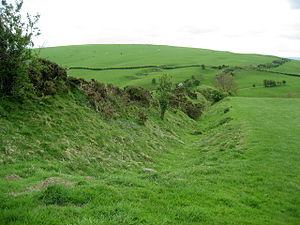This is an old revision of this page, as edited by DragonofBatley (talk | contribs) at 22:08, 15 December 2021 (Nominated for deletion; see Misplaced Pages:Articles for deletion/Welsh Lost Lands (2nd nomination).). The present address (URL) is a permanent link to this revision, which may differ significantly from the current revision.
Revision as of 22:08, 15 December 2021 by DragonofBatley (talk | contribs) (Nominated for deletion; see Misplaced Pages:Articles for deletion/Welsh Lost Lands (2nd nomination).)(diff) ← Previous revision | Latest revision (diff) | Newer revision → (diff)| An editor has nominated this article for deletion. You are welcome to participate in the deletion discussion, which will decide whether or not to retain it.Feel free to improve the article, but do not remove this notice before the discussion is closed. For more information, see the guide to deletion. Find sources: "Welsh Lost Lands" – news · newspapers · books · scholar · JSTOR%5B%5BWikipedia%3AArticles+for+deletion%2FWelsh+Lost+Lands+%282nd+nomination%29%5D%5DAFD |
You can help expand this article with text translated from the corresponding article in Welsh. (December 2021) Click for important translation instructions.
|
| An editor has nominated this article for deletion. You are welcome to participate in the deletion discussion, which will decide whether or not to retain it.Feel free to improve the article, but do not remove this notice before the discussion is closed. For more information, see the guide to deletion. Find sources: "Welsh Lost Lands" – news · newspapers · books · scholar · JSTOR%5B%5BWikipedia%3AArticles+for+deletion%2FWelsh+Lost+Lands%5D%5DAFD |


The Lost Lands of Wales, a minor political idea of the mid 1960s, called into question the status of areas along the east side of the England–Wales border which its proponents regarded as Welsh. The idea was propounded by the Lost Lands Liberation League, and related to parts of the counties of Cheshire, Gloucestershire, Herefordshire and Shropshire.
History
| This section may contain information not important or relevant to the article's subject. Please help improve this section. (August 2014) (Learn how and when to remove this message) |
The Council of Wales and the Marches, administered from Ludlow Castle, was initially established in 1472 by Edward IV of England to govern the lands held under the Principality of Wales which had become directly administered by the English crown following the Edwardian conquest of Wales in the 13th century.
Some Marcher lordships were added to adjoining English counties: Ludlow, Clun, Caus and part of Montgomery were incorporated into Shropshire; Wigmore, Huntington, Clifford and most of Ewyas were included in Herefordshire; and that part of Chepstow east of the River Wye was included in Gloucestershire.
The Council of Wales, based at Ludlow Castle, was reconstituted as the Council of Wales and the Marches, with statutory responsibilities for the whole of Wales together with, initially, Cheshire, Shropshire, Herefordshire, Worcestershire and Gloucestershire. The City of Bristol was exempted in 1562, and Cheshire in 1569. The Council was eventually abolished in 1689, following the "Glorious Revolution" which overthrew James II (VII of Scotland) and established William III (William of Orange) and Mary II as king and queen.
English and Welsh boundaries
Main article: Laws in Wales Acts 1535–1542The Marches remained outside the shire system, and nominally outside the control of the English monarchy, until the first Laws in Wales Act was introduced in 1535 under Henry VIII. This, and a further Act in 1542, annexed Wales to England and created a single state and legal jurisdiction, commonly referred to as England and Wales. The powers of the marcher lord-ships were abolished, and their areas formed into new counties, or amalgamated into existing ones.
The boundary between England and Wales, which has existed ever since, was effectively fixed. In the border areas, five new counties were created - Denbighshire, Montgomeryshire, Radnorshire, Brecknockshire and Monmouthshire - and Flintshire gained some additional territory. However, several of the marcher Lordships were incorporated in whole or in part into English counties. The lordships of Ludlow, Clun, Caus and part of Montgomery were incorporated into Shropshire; and Wigmore, Huntington, Clifford and most of Ewyas were included in Herefordshire. According to John Davies:
Thus was created the border between Wales and England, a border which has survived until today. It did not follow the old line of Offa's Dyke nor the eastern boundary of the Welsh dioceses; it excluded districts such as Oswestry and Ewias, where the Welsh language would continue to be spoken for centuries, districts which it would not be wholly fanciful to consider as Cambria irredenta. Yet, as the purpose of the statute was to incorporate Wales into England, the location of the Welsh border was irrelevant to the purposes of its framers.
The Counties (Detached Parts) Act 1844 later abolished several enclaves. One of these, Welsh Bicknor, was an exclave of Monmouthshire between Gloucestershire and Herefordshire.
Until the Welsh Disestablishment in 1920 the Diocese of St Asaph covered parts of north-west Shropshire. The parishes transferred to the Diocese of Lichfield were: Criftins, Hengoed, Kinnerley, Knockin,Llanyblodwell, Llanymynech, Melverley, Morton, Oswestry, St Martins, Selattyn,Trefonen, Weston Rhyn and Whittington
Lost Lands Liberation League
The Lost Lands Liberation League was reportedly a minor group in the 1960s claiming to recover the 'Lost Lands' for Wales. Some Welsh nationalist organisations have campaigned on the issue, although Plaid Cymru does not. The group is associated with Gethin ap Gruffydd.
See also
References
- William Searle Holdsworth, "A History of English Law," Little, Brown, and Company, 1912, pg. 502
- Welsh Joint Education Committee: The Council of Wales and the Marches
- J. A. Ransome, This Realm of England
- John Davies, A History of Wales, Penguin, 1993, ISBN 0-14-028475-3